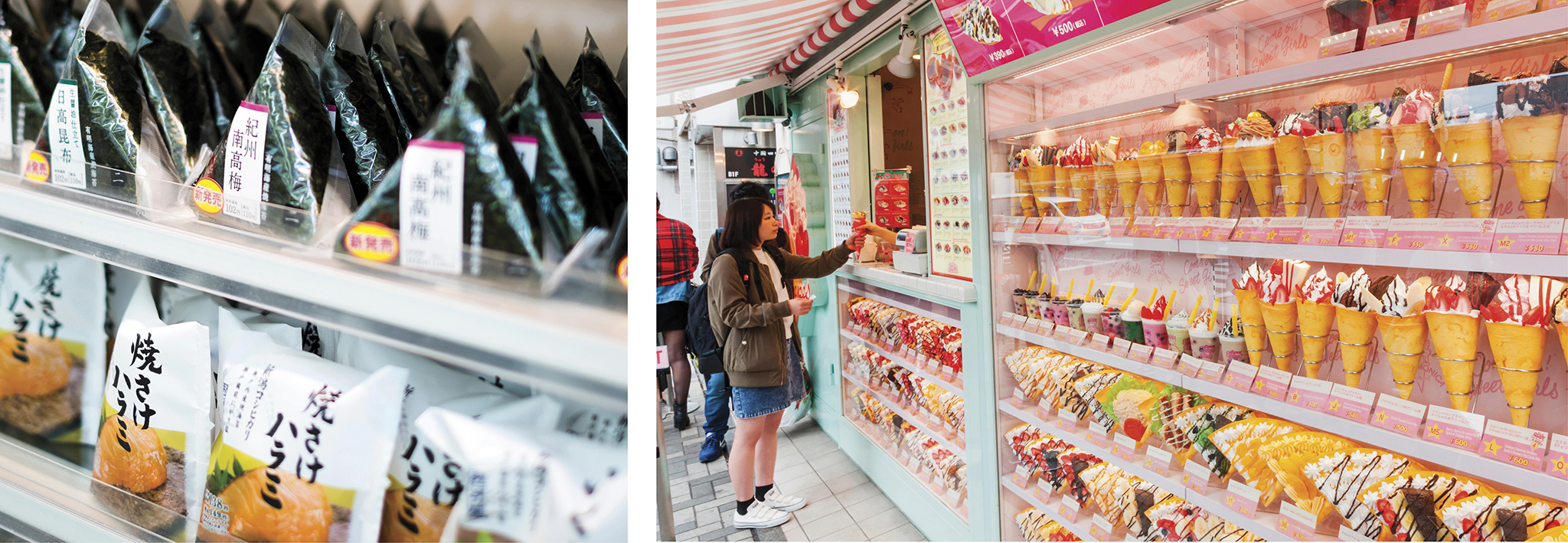g Edible Japan g Contents
おやつ
snacks
Eating on the go
Whether it’s senbei (rice crackers) in front of the TV or a sneaky melonpan (sweet bun) in the office, Japan loves to snack. Visit any convenience store and the variety and volume of oyatsu (snack) options might leave you wondering how the Japanese got their reputation for being svelte and healthy.
Be More Japan Snacks

D Left to right: Konbini stock a mind-boggling array of snack options; rice crackers come in many varieties.
Alongside daily necessities, ready-made meals and drinks, konbini (convenience stores) like 7-Eleven, Family Mart, and Mini-Stop are where kids with a few spare yen can grab cheap gum, candy, and classics like Umaibo, a puffed corn stick that comes in cheese, corn potage, teriyaki, and many other variations. Sharing the aisles with that are chocolates and chewy treats—the likes of Pocky chocolate-covered biscuit sticks and fruit-flavored Hi-Chew—as well as local chip brands with flavors that run from standard salt to consommé, pizza, pickled plum (ume), salted seaweed (nori shio), and fish roe (mentaiko). Then come the more traditional savory options in the shape of senbei, hard rice crackers that usually have a soy tang to them but can also be sweetened, wrapped in seaweed, or flavored with sesame. Like wagashi, they are often eaten with tea.
Overlapping the culinary middle ground between snack and meal, convenience stores also sell rice balls known as onigiri. Although they aren’t actually balls—most are triangular—onigiri are ideal for a cheap lunch or a quick refuel, functioning as a Japanese equivalent to a sandwich. Typical single fillings inside the dried seaweed-wrapped rice include konbu seaweed, pickled plum, salmon flakes, and tuna with mayonnaise.
Away from the konbini, cake shops and bakeries offer a treasure trove of sweet treats. Creamy mille-feuille and red bean paste–filled donuts (an-donatsu) are common goodies, but arguably the most sumptuous offerings are crepes. Nothing like the crepes you find in France, the Japanese version is all about excess. They are best typified by the colorful creations you find at Café Crepe in Harajuku, Tokyo—crepe wraps bursting with whipped cream and fruit then lathered in chocolate and caramel sauce, some with a chunk of cheesecake or a scoop or two of ice cream squeezed in for good measure.
Be More Japan Snacks
taste the region

kit-kats
One trend you will notice while in Japan is regionality. Popular snack brands often create region-only versions based on local produce to tap into Japan’s unrelenting custom of omiyage—bringing souvenirs home for friends, family, and co-workers. The epitome of this is Kit-Kats, with regional flavors including hojicha tea in Kyoto, lip-tingling shichimi spice mix in the Shinshu region, and wasabi in Shizuoka, as well as Japan-only varieties like sake and matcha. The brand initially became popular in Japan because the Japanese pronunciation sounds like kitto katsu, or “good luck,” making it a suitable gift to give a little encouragement.

D Left to right: Onigiri are a common sight in konbini throughout Japan; Japanese crepes are a popular street food and come in hundreds of flavors.
